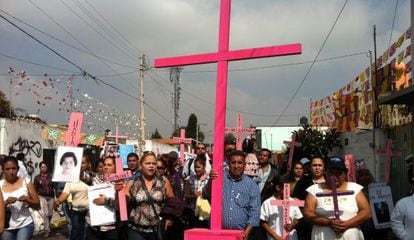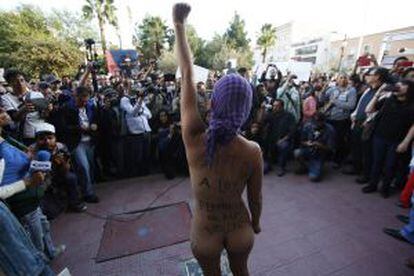Five women die a violent death every day in Mexico
Authorities refusing to acknowledge existence of a problem, advocacy groups claim

“Her wrists and legs were tied up, she was blindfolded… She was naked and bruised all over...Two shots in the head ended her life,” says Lenin Vázquez about his sister Xóchitl, murdered at the age of 17. “Nobody knows who killed her… A neighbor found her dead.”
The victim was living with her boyfriend just a few streets down from the town hall in Chalco, one of 125 municipalities in the state of Mexico, in the geographical center of the country.
“The boyfriend says he knows nothing. He left the house at 6am to go to work and they went in to kill her right after that,” continues Lenin Vázquez.
Lucero was killed after filing a complaint against her rapists; Diana’s body was tossed into a canal; Alejandra was raped by three police officers... the list goes on
Xóchitl’s case remains in limbo. Nobody was brought in for questioning, and the case was reported as a burglary even though nothing was taken from the house, not even a diamond ring and a very expensive watch that were lying around, says her brother.
Yet this is far from a unique tragedy. Mexico has become a hostile place for women. In 2012 and 2013, 3,892 of them were brutally murdered, making for a rate of more than five a day, according to the latest report by the National Citizen Observatory against Femicide, an umbrella group of 49 human rights associations.
Obtaining acknowledgment of this existing brutality against Mexico’s women has turned into a battle with no victories to report.
The state of Mexico, the birthplace of President Enrique Peña Nieto, is a clear example of the ongoing aggression: Lucero was killed after filing a complaint against her rapists; Diana was liquidated and her body tossed into a canal; Alejandra was raped by three police officers... the list goes on.
“Thousands have died. Their bodies are hacked to pieces; others get kidnapped and you never hear about them again,” says María de la Luz Estrada, executive coordinator for the Observatory.
The femicide rate in Mexico — up to three victims for every 100,000 women — is comparable with Panama, Nicaragua and Costa Rica, according to the Small Arms Survey, a project of the Graduate Institute of International and Development Studies based in Geneva, Switzerland.
The state of Mexico, which has been ruled by the Institutional Revolutionary Party (PRI) for over 84 years, is home to more than 15 million people, of whom 51.2 percent are women. In the last nine years, the Observatory has counted 1,596 killings of women — two a day — in a region where femicide has been encoded as a specific crime, as in 30 other Mexican states.
“Women are the weakest link in this society,” says Manuel Amador Velázquez, a sociologist who co-authored Diálogos Interdisciplinarios sobre Violencia Sexual (Interdisciplinary Dialogues on Sexual Violence). Low literacy rates among women, a lack of access to the justice system and poverty are three factors driving violence in the state of Mexico.
Guadalupe Reyes still hopes to find her 17-year-old daughter alive. Every morning she goes out to scour the streets of Tecámac, another town in Mexico state, looking for clues about Mariana’s whereabouts. The last time she was seen alive was September 17, when she went down to make some photocopies at a store located not 100 meters from her home.
Bernardo González, Mariana’s father, is a defeated man. “When we went out looking for her it was around 11pm. She had left at nine. We asked the police for help and their reply was, ‘She’s probably with her boyfriend’.”

Mariana is now one of over 1,554 missing people in the state, of which 70 percent are women. Of these, 60 percent are aged 10 to 17, according to the National Registry of Missing Persons.
“The state of Mexico shows a systematic pattern that is similar to Ciudad Juárez,” says Guadalupe Ramos, a representative for the Latin America and Caribbean Committee for the Defense of Women’s Rights (Cladem). During the worst year on record, 2010, one woman died in Ciudad Juárez every 20 hours.
The most dangerous municipalities in the state, adds Ramos, are Ecatepec, Netzahualcóyotl, Chalco and seven others, most located in the northwestern portion of the territory.
This expert claims that authorities are refusing to acknowledge the existence of a problem.
Taking the lid off this sewer would deliver a political blow to the government, both at the federal and state levels”
Ivonne Acuña, scholar
“Taking the lid off this sewer would deliver a political blow to the government, both at the federal and state levels,” agrees Ivonne Acuña, of the Iberoamerican University.
As though to confirm this, the State Attorney’s Office refused to give this newspaper any kind of information on the matter.
For the last nine years, more than five women have been raped every day in the state of Mexico, according to the Executive Secretariat of the National System for Public Safety.
“Authorities have not only omitted the murders, the abductions and all the forms of abuse, they have also reduced the issue to a matter of domestic violence,” says Estrada. “They base their analysis on subjective assessments: prostitution, drug trafficking; sometimes they even tie the murders to the victim’s sentimental situation and to a lack of moral values.”
Ramón (an assumed name) has personally seen the blood running though the state of Mexico. As a firefighter, he has seen it all.
Someone found a black bag at a park. Inside were the pieces of a young woman’s body”
Ramón, firefighter
“One day we received a call from a person who’d found a black bag at a park. Inside were the pieces of a young woman’s body: they’d cut off her legs, arms and head,” he says. His cellphone contains photographs and videos of some of the cases. The last images show 13 bodies found at the bottom of Remedios River, a waste water canal that crosses the towns of Ecatepec and Netzahualcóyotl.
Just one day earlier, on October 13, the State Attorney’s Office had denied that this waterway is a dump for bodies. Yet even state authorities admitted to finding over 7,000 remains: 6,962 allegedly belonging to animals, 60 to the same individual, and 19 more still under analysis.
The admission came after an advocacy group called Solidaridad por las Familias said that cleaning work on the canal had yielded 46 bodies.
“Firefighters and paramedics have offered us information, and that is how we came up with that figure,” explains David Mancera, a member of the group.
Mariana’s mother wants Mexican authorities to clear up what happened to her daughter and to all the missing women. Her living room table displays several photographs of the young woman and many figures of saints that she prays to, hoping they will deliver Mariana home safe and sound. Hope is the only thing that keeps burning bright in this house: “Hopefully some day we will get an answer.”










































